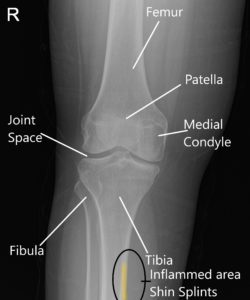Shin Splints – Cause and Management
Overview
Shin splints, or medial tibial stress syndrome, represent a frequent ailment especially among athletes who engage in running and jumping. The discomfort associated with shin splints typically manifests along the inner edge of the shinbone (tibia), where muscles attach to the bone. This condition is primarily the result of repetitive stress which overwhelms the body’s capacity to repair and strengthen the bone and surrounding tissues.
The pain occurring along the inner side of the shin bone especially after physical activity is known as shin splints. It is also known as medial tibial stress syndrome. The condition is common among runners, dancers, and military recruits. The patients usually present with a history of a sudden increase in physical activity.
The shin bone is the long bone in front of your lower leg. The shinbone or the tibia has a lot of muscles and tendons attached especially on the inner side. The periosteum is the tough tissue covering the bone. Rigorous and repetitive physical activity may lead to inflammation of the periosteum and the tendons attached to the shin bone.

X-ray of a normal knee showing the area of inflammation in shin splints.
The activity most commonly associated is running. New runners and runners changing their duration, intensity, and frequency may experience shin splints. Some of the risk factors are people having flat feet. A foot having improper arch support on the inner side of the sole is known as flat feet.
Additionally, runners wearing improper shoe wear or wearing worn-out footwear are susceptible to developing shin splints. Dancers and athletes with high impact activity are commonly affected. The patient usually complains of symptoms after the initial few days of intense activity.
Symptoms of Shin Splints
The hallmark symptom of shin splints is a throbbing or aching pain along the inner part of the lower leg, which may:
- Start as a dull ache and intensify to a sharp pain
- Be accompanied by mild swelling
- Typically worsen during exercise and alleviate during rest
The commonest symptom of shin splints is pain in the front of the leg. The pain may be associated with mild swelling. The pain of shin splints is usually mild initially and goes away on stopping the exercise. But gradually the pain may become consistent and increase in intensity.
The pain may be sharp or dull in character and is usually present both during and after the activity. The inner side of the shin bone may be tender to touch. There may be a small bump consistent with swelling which is sore to touch.
Diagnosis
The diagnosis of shin splints involves a detailed history and physical examination. A detailed history of training intensity and frequency of running is taken. Physical examination of the tender shin and feet is done.
Foot examination may include tests to look for weakened arches on the inner side of the sole. The physician may also order other investigations such as X-ray. A bone scan or MRI may be requested if the physician suspects stress fracture.
Differential Diagnosis
A doctor’s examination is necessary to diagnose shin splints. Some other conditions may also resemble shin splints. Physician consultation is, therefore, necessary to rule out other causes of leg pain.
- Stress fractures are hairline fractures occurring due to repetitive stress/overuse. The condition is diagnosed usually with the help of imaging studies such as bone scan and MRI.
- Partial tendon tears may result in tendonitis or inflammation of the tendons. The condition may resemble shin splints.
- Very rarely, a chronic compartment syndrome may develop in the pressure within the leg muscles increases to dangerous levels.
Management
The management of shin splints is conservative which involves measures to reduce inflammation.
- Rest to the part is important as it helps the inflammation to go down.
- Icing helps to decrease the inflammation and reduces pain.
- NSAIDs such as Ibuprofen and Aleve reduce inflammation. They are used cautiously in patients prone to develop gastric ulcers and bleeding.
- Compression bandages reduce swelling and prevent additional swelling in the leg.
Prevention
Shin splint is a common condition affecting athletes and non-athletes alike. However preventive measures greatly reduce the chances of developing shin splints.
- Proper shoewear is important to prevent shin splints. People having flatfeet benefit from using shoe inserts for proper balancing of the forces when they exercise. Orthotics aid in stabilizing the ankle and distribute forces evenly.
- Leg muscles strengthening and stretching exercises help in reducing the chances of shin splints. The strengthened calf muscles are less likely to develop inflammation of the periosteum upon repetitive use.
- Change of training and modifying the exercise regimen prevents shin splints. Small increments in running distance and cross-training have been associated with a lower occurrence of leg pain.
Recovery from leg pain is gradual but mostly complete. However, it is important to return to activity only after a period of rest (generally 2 weeks). Consulting a physician regarding your training and activity adjustment is beneficial.
Alternating running with lower impact sports such as cycling and swimming may help strengthen the muscles. Consider consulting a sports physician for proper evaluation and management of shin splints.
Long-Term Outlook and Considerations
While shin splints are generally not serious, without appropriate management, they can lead to prolonged discomfort and even more severe injuries. Education on proper techniques and awareness of the signs of overuse are crucial for anyone engaged in activities with high impact on the lower legs.
Conclusion
Shin splints are a manageable and preventable condition with a comprehensive understanding of their causes, symptoms, and treatments. By incorporating proper preventative measures and seeking appropriate care when symptoms arise, individuals can maintain active and healthy lifestyles without the disruption of this painful condition.
Do you have more questions?
What exactly causes the pain in shin splints?
The pain in shin splints is caused by inflammation of the muscles, tendons, and the thin layer of tissue covering the shinbone due to overuse or stress.
How can I differentiate shin splint pain from other leg pains?
Shin splint pain is typically localized along the inner edge of the shinbone, is exacerbated by physical activity, and improves with rest. Other leg pains might not follow this pattern and could be due to different causes.
Is it safe to keep running if I think I have shin splints?
It is not safe to continue running with shin splints as it can lead to worsening of the symptoms or more serious injuries. Rest and treatment are recommended.
Are there specific stretching exercises that prevent shin splints?
Specific stretching exercises targeting the calf muscles, like standing calf stretches and seated shin stretches, can help prevent shin splints.
How long do shin splints typically last?
The duration of shin splints varies but typically resolves with proper rest and treatment within a few weeks to a couple of months.
Can shin splints lead to permanent damage?
While shin splints themselves do not cause permanent damage, neglecting them can lead to more severe conditions like stress fractures.
What are the best types of footwear to prevent shin splints?
Footwear that provides good arch support, cushioning, and fits well is best for preventing shin splints.
How effective are orthotic devices in treating shin splints?
Orthotic devices can be effective in treating shin splints, especially for individuals with biomechanical issues like flat feet.
Are children at risk for shin splints?
Children, particularly those in sports involving running and jumping, can develop shin splints, though it’s less common than in adults.
What role does diet play in the prevention and management of shin splints?
A balanced diet rich in calcium and vitamin D can support bone health and may help in the management and prevention of shin splints.
Can shin splints recur after they have healed?
Yes, shin splints can recur if preventive measures are not followed or if there is a return to high-impact activities too quickly.
Are there any alternative therapies for shin splints?
Alternative therapies like acupuncture, massage therapy, and the use of compression sleeves may provide relief for some individuals
How do I know if my shin splints have healed enough to resume activity?
Resumption of activity should be gradual after the pain has completely subsided and with no signs of swelling.
What is the best way to apply ice to shin splints?
Ice should be applied in a cloth-covered pack to the affected area for 15-20 minutes every two to three hours during the initial days after symptoms appear.
Is there a correlation between shin splints and flat feet?
There is a strong correlation between flat feet and shin splints due to the increased stress on the lower leg muscles and tendons.
How can I adjust my running technique to avoid shin splints?
Adjusting your running technique to include shorter strides and ensuring your foot strikes below your hips can help avoid shin splints.
Are there any specific medications recommended for shin splints?
Over-the-counter anti-inflammatory medications, such as ibuprofen or aspirin, can be used to reduce pain and inflammation.
Can shin splints be completely cured?
With appropriate treatment and preventive strategies, shin splints can usually be completely resolved.
What preventive measures can be taken during high-impact sports?
Wearing appropriate footwear, ensuring proper technique, and maintaining astrength training in your routine can all help prevent shin splints during high-impact sports.
How often should I replace my running shoes to prevent shin splints?
Running shoes should be replaced every 300-500 miles to ensure adequate cushioning and support, reducing the risk of shin splints.
Can walking cause shin splints as well as running?
While less common, walking—especially if excessive or on hard surfaces—can also lead to shin splints, particularly if footwear is inadequate.
Are shin splints a sign of a more serious condition?
Generally, shin splints are not a sign of a more serious condition, but if left untreated, they can lead to complications like stress fractures.
How does body weight impact the recovery from shin splints?
Higher body weight can extend recovery time as more stress is placed on the shins during recovery, necessitating more cautious management.
What are the signs that I should seek professional help for shin splints
You should seek professional help if the pain persists despite rest and self-care, if there is severe swelling, or if you suspect a fracture.

Dr. Suhirad Khokhar
My name is Dr. Suhirad Khokhar, and am an orthopaedic surgeon. I completed my MBBS (Bachelor of Medicine & Bachelor of Surgery) at Govt. Medical College, Patiala, India.
I specialize in musculoskeletal disorders and their management, and have personally approved of and written this content.
My profile page has all of my educational information, work experience, and all the pages on this site that I've contributed to.
